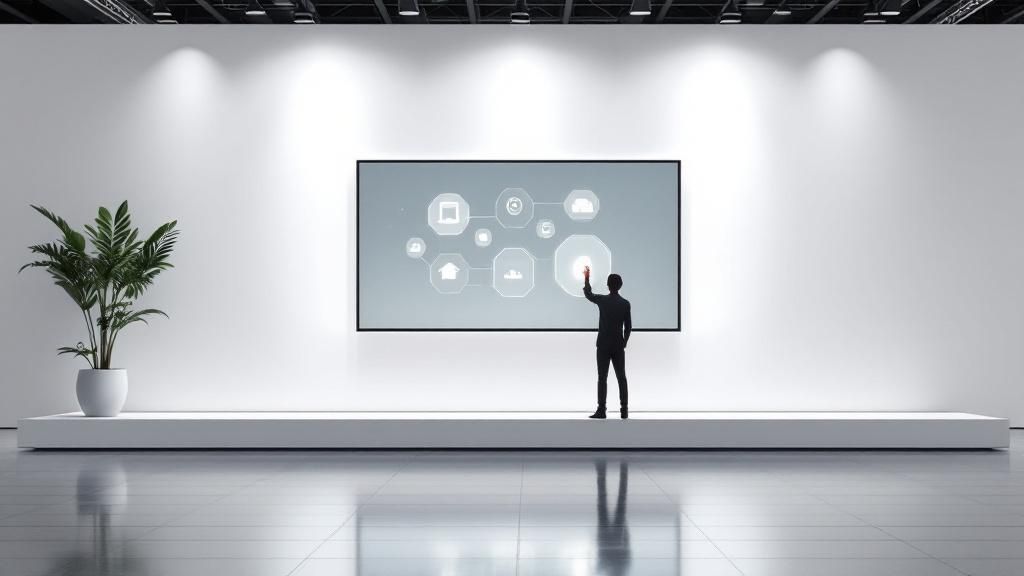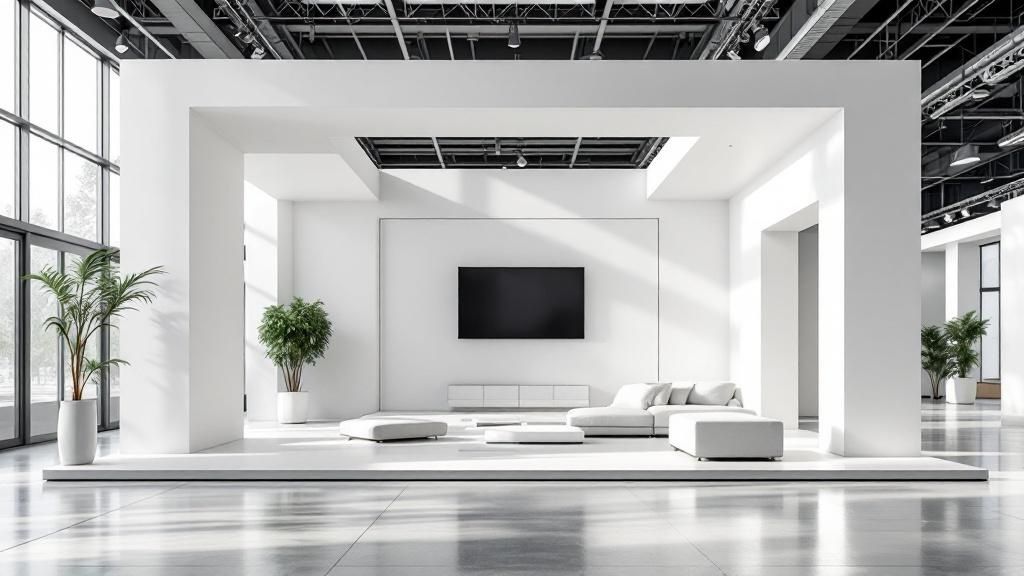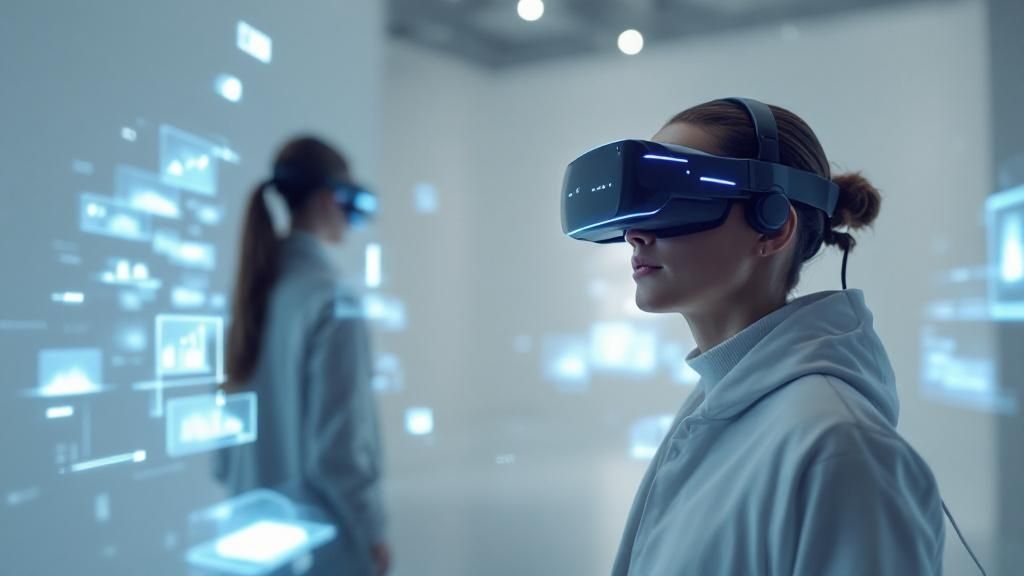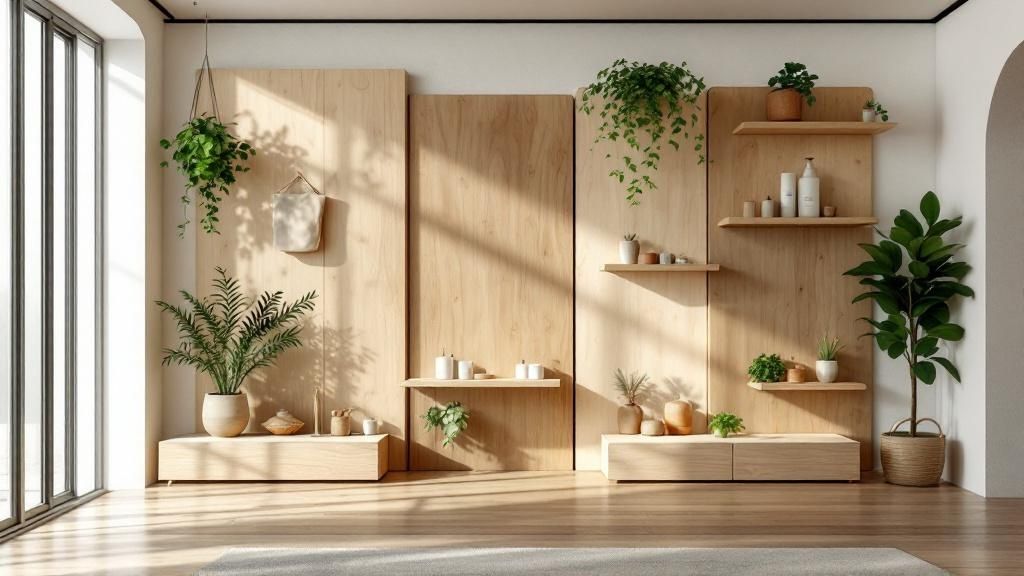Your cart is currently empty.

In the competitive world of trade shows and exhibitions, a standard display no longer cuts it. To capture attention, foster genuine connections, and leave a lasting impression, your booth must do more than just exist; it needs to create an experience. This guide moves beyond generic advice to deliver innovative and practical exhibition display ideas designed to transform your space.
We will explore nine forward-thinking concepts that help you engage visitors on a deeper level. From immersive VR/AR experiences and interactive digital walls to sustainable eco-friendly designs and minimalist aesthetics, you will find actionable strategies tailored for diverse industries. Each idea is structured to provide clear implementation steps, material recommendations, and real-world scenarios.
Whether you're a seasoned exhibitor or organising your first event, these concepts will equip you to build a display that not only showcases your products but also powerfully communicates your brand story. Prepare to move beyond the traditional booth and create a destination that captivates your audience, generates meaningful leads, and delivers a measurable return on your investment. Let's delve into the strategies that will make your next exhibition a standout success.
1. Interactive Digital Walls
Interactive digital walls transform a passive viewing experience into an active, memorable engagement. These large-scale displays respond to touch, gestures, or even proximity, allowing visitors to dive deep into your brand’s story, product features, or data visualisations. Instead of just telling attendees about your offerings, you let them discover the information for themselves in a dynamic and visually stimulating way.

Consider how major brands leverage this technology. Tech giants use them at conferences to showcase software ecosystems, while automotive brands like BMW have created digital configurators where customers can design their ideal car on a life-sized screen. These powerful exhibition display ideas are perfect for industries with complex products or extensive portfolios, such as real estate, tech, and automotive, as they can present vast amounts of information without overwhelming the physical space.
Implementation Tips
To ensure your interactive wall is a success, focus on the user experience.
- Intuitive Interface: Design the user interface (UI) to be simple and self-explanatory. If a visitor needs instructions, the design isn't intuitive enough.
- Clear Calls-to-Action: Guide users on what to do next. Use prompts like "Touch to Explore," "Swipe to See More," or "Build Your Own."
- Technical Support: Have a technician on standby or easily reachable. Technology can be unpredictable, and you need a plan for immediate troubleshooting.
- Fallback Content: If the interactive element fails, ensure the screen defaults to a visually appealing video loop or a static information graphic so the display is never blank.
For more inspiration on leveraging technology in your displays, explore these innovative interactive event ideas that can help capture and hold audience attention.
2. Modular Display Systems
Modular display systems offer unparalleled flexibility and are a cornerstone of modern exhibition display ideas. These systems consist of standardised, reconfigurable components that can be assembled in countless configurations. This allows exhibitors to adapt their stand to different venue sizes and floor plans, creating a fresh look for each event while maintaining perfect brand consistency. Instead of a one-size-fits-all booth, you get a customisable solution that evolves with your marketing needs.

This approach is highly cost-effective in the long run, eliminating the need to purchase new displays for every trade show. Companies like Skyline Displays and Nimlok have popularised these systems, demonstrating how a single kit can be transformed from a simple 3x3 metre backdrop into a complex, multi-functional 6x6 metre stand. This adaptability makes them ideal for businesses that frequently exhibit, such as marketing agencies, tech start-ups, and educational institutions, allowing them to maximise their return on investment.
Implementation Tips
To get the most out of your modular system, careful planning and organisation are key.
- Plan Layouts in Advance: Before each event, use design software or templates to plan your specific configuration. This ensures you have the right components and a clear assembly plan.
- Create a Component Inventory: Keep a detailed checklist of every part, from frames and connectors to graphic panels. This prevents items from being lost and simplifies packing.
- Train Your Team: Ensure the staff responsible for setup are properly trained on assembly and disassembly procedures. A smooth setup process saves valuable time and reduces stress.
- Invest in Quality Cases: Durable, well-designed carrying cases protect your investment during transit and storage, keeping components organised and ready for the next show.
3. Immersive VR/AR Experiences
Immersive Virtual and Augmented Reality (VR/AR) experiences are powerful exhibition display ideas that transport visitors beyond the confines of your booth. VR immerses users in a completely digital environment, while AR overlays digital information onto the real world. This technology allows you to showcase products in unique contexts, simulate complex scenarios, or provide unforgettable interactive training, creating a deep emotional connection with your audience.

This approach is highly effective for brands wanting to demonstrate value in a tangible way. For instance, car manufacturers like Volvo use VR to run immersive safety demonstrations, while IKEA's pioneering AR app lets customers visualise furniture in their own homes. These experiences are not just novelties; they are practical tools that bridge the gap between imagination and reality, making them ideal for the automotive, real estate, and retail sectors.
Implementation Tips
To deliver a seamless and impactful VR/AR experience, meticulous planning is essential.
- Keep it Brief: Design experiences to last between 2-5 minutes to maximise throughput and maintain high engagement without causing fatigue.
- Prioritise Hygiene: Provide sanitisation stations with wipes for headsets and controllers. Assuring visitors of cleanliness is crucial for participation.
- Guide the User: Have trained staff available to assist users, explain the controls, and guide them through the experience to prevent confusion.
- Manage Queues: Create a comfortable and visually engaging waiting area. Use screens to show what the current user is seeing to build anticipation.
- Offer Alternatives: Be mindful of motion sickness. Have a non-headset alternative, like a guided screen tour, for those who may feel unwell.
To envision the future of interactive displays and experiences, consider these groundbreaking pixel streaming use cases that can redefine immersive exhibition experiences for 2025 and beyond.
4. Product Theater Presentations
Product theater presentations transform a section of your exhibition stand into a dedicated space for scheduled demonstrations, expert talks, and live showcases. These mini-theatres create a focused environment, drawing in attendees who are genuinely interested in a deeper dive into your offerings. Instead of hoping passersby stop for a quick chat, you provide a structured, high-value experience that positions your brand as an authority.

This strategy is famously used by tech giants like Salesforce at their Dreamforce conference and was popularised by Apple’s in-store theatre concept. By creating an event-within-an-event, you capture an engaged audience for a set period, allowing for more complex storytelling. This approach is one of the most effective exhibition display ideas for companies in software, manufacturing, or healthcare, where detailed explanations and live demonstrations are crucial to communicating value.
Implementation Tips
To ensure your product theatre captivates its audience, careful planning is key.
- Promote the Schedule: Advertise your presentation times well in advance on social media, in email newsletters, and on signage around your stand. Build anticipation.
- Keep it Concise: Aim for presentations under 15 minutes. This respects attendees' limited time and keeps the energy high, leaving them wanting to learn more.
- Provide Comfortable Seating: A small investment in comfortable chairs or tiered seating can significantly increase the number of people who stay for the entire presentation.
- Record the Sessions: Film your presentations to create valuable marketing content. You can also enhance the live experience with pre-recorded, compelling product demo videos to ensure a flawless showcase.
5. Sustainable Eco-Friendly Displays
Sustainable eco-friendly displays demonstrate a brand's commitment to environmental responsibility, creating a powerful connection with conscious consumers. These exhibition display ideas are built using responsibly sourced, recyclable, or biodegradable materials and are designed for minimal environmental impact. By prioritising sustainability, you not only reduce your event's carbon footprint but also align your brand with the growing global movement towards greener practices, enhancing your public image and appeal.
Brands like Patagonia have long championed this approach, using recycled materials and minimalist designs that tell a powerful story of conservation. Similarly, companies within the B Corp movement often create booths designed for disassembly and reuse, showcasing innovation in both product and ethics. These displays are exceptionally effective for industries with a focus on wellness, nature, or corporate social responsibility, but their universal appeal makes them a smart choice for any brand looking to build trust and resonate with modern audiences.
Implementation Tips
To create an authentic and effective eco-friendly display, your commitment must go beyond surface-level claims.
- Partner with Certified Suppliers: Work with builders and material suppliers who hold recognised environmental certifications (like FSC for wood or B Corp for business practices) to ensure your materials are genuinely sustainable.
- Communicate Your Story: Use small, well-placed signage to explain your material choices. Let visitors know why you chose reclaimed wood, recycled plastics, or non-toxic inks. This turns your booth into an educational experience.
- Design for Disassembly: Plan for your display's end-of-life from the very beginning. Use modular components, avoid permanent glues, and choose materials that can be easily separated for recycling or reuse at future events.
- Track and Report Impact: If possible, measure the positive impact of your choices, such as the amount of waste diverted from landfill or the reduction in transport emissions. Sharing these metrics can add significant credibility to your sustainability claims.
6. Multi-Sensory Experience Zones
Multi-sensory experience zones elevate your exhibition display from a simple visual presentation to a fully immersive brand encounter. These curated spaces are designed to engage multiple senses at once, using a strategic combination of lighting, soundscapes, scents, and textures. By appealing to more than just sight, you create a powerful emotional connection and a far more memorable experience that helps your brand stand out in a crowded exhibition hall.
Think of how brands like Lush use the distinct aroma of their products to draw people in, or how Starbucks creates a sensory lab with the smell of coffee and the sound of grinding beans. These multi-sensory exhibition display ideas are particularly effective for food and beverage, wellness, automotive, and luxury retail brands, where the feel, smell, and sound are just as important as the look. The goal is to build an atmosphere that embodies your brand's essence, leaving a lasting impression long after the event.
Implementation Tips
To craft a successful multi-sensory zone, you need careful planning and execution.
- Test Combinations: Before the event, test how different sensory elements work together. A pleasant scent can become overpowering when paired with the wrong music or lighting.
- Offer Sensory-Free Zones: Recognise that intense sensory input isn't for everyone. Provide a quieter, neutral area nearby for visitors who may feel overwhelmed.
- Consider Cultural Context: Scents and sounds can have different meanings across cultures. Ensure your choices are universally positive or specifically tailored to your target audience.
- Train Your Staff: Your team should understand the purpose of each sensory element. They need to explain the experience to visitors and monitor comfort levels throughout the day.
For more insights into creating engaging spaces, this guide on designing event experiences offers valuable principles that can be applied to your sensory zones.
7. Social Media Integration Displays
Social media integration displays turn your physical exhibition stand into a dynamic, real-time conversation hub. By showcasing live social media feeds, hashtag campaigns, and user-generated content, you create an ever-changing backdrop that encourages visitor participation. These exhibition display ideas bridge the gap between your on-site presence and online community, amplifying your message far beyond the event floor.
This strategy has been famously used by global brands to generate buzz. Think of Coca-Cola's #ShareACoke campaign, where personalised content was shared across screens, or how brands like GoPro display breathtaking user-submitted adventure feeds. These displays are exceptionally effective for consumer-facing industries like retail, hospitality, and entertainment, as they tap into the desire for social connection and recognition, transforming attendees from passive observers into active brand advocates.
Implementation Tips
To make your social media wall a drawcard, focus on seamless execution and engagement.
- Create a Compelling Hashtag: Develop a short, memorable, and unique hashtag for your event. Promote it clearly on your display and throughout your stand.
- Provide Participation Incentives: Encourage attendees to post by offering rewards. This could be a prize for the "best photo," a small giveaway for anyone who posts, or a feature on your main screen.
- Implement Content Moderation: Use a social media aggregation tool with automated or manual moderation filters. This ensures only appropriate and on-brand content makes it to your public display.
- Monitor and Respond Actively: Have a dedicated team member monitoring the social feed. Liking, sharing, and responding to posts in real-time shows you are listening and values your audience’s contribution.
8. Minimalist Clean Design
A minimalist clean design leverages the power of simplicity, using clean lines, generous white space, and a curated focus on essential elements. This approach moves beyond mere aesthetics to create a sophisticated, uncluttered environment where your key message can resonate without distraction. By stripping away visual noise, you guide the visitor’s attention directly to what matters most: your product, your brand, or your core value proposition.
This style is famously championed by brands like Apple, whose exhibition and retail spaces are masterpieces of focused design, and the Scandinavian design movement, which prioritises function and form. These powerful exhibition display ideas are ideal for luxury goods, high-tech products, and professional services, as they convey confidence, quality, and clarity. The "less is more" philosophy ensures every component of your display serves a distinct purpose, enhancing the perceived value of your offerings.
Implementation Tips
To execute a minimalist design effectively, precision is everything.
- Focus on Premium Materials: Simplicity exposes the quality of your materials. Opt for high-grade finishes like polished concrete, natural wood, brushed metal, or matte laminates to convey a sense of premium quality.
- Perfect the Finishing: Every joint, edge, and surface must be flawless. Imperfections are highly visible in a minimalist setup, so invest in superior craftsmanship.
- Use Strategic Lighting: Lighting becomes a design element in itself. Use spotlights to create focal points, backlighting to add depth, and subtle ambient light to set a sophisticated mood.
- Limit Your Message: Stick to one or two key messages. Overloading a minimalist stand with text or graphics undermines the entire concept and creates clutter.
9. Pop-up and Temporary Installations
Pop-up and temporary installations are dynamic exhibition structures designed for rapid deployment and maximum impact, often in non-traditional or unexpected locations. These short-term displays create excitement through their limited availability and innovative designs, generating significant buzz and foot traffic. Instead of waiting for customers to visit a permanent location, you bring a curated brand experience directly to them, fostering a sense of discovery and urgency.
Luxury brands have masterfully used this strategy. Consider Louis Vuitton's globe-trotting exhibitions that tour major cities or Chanel's ephemeral pop-up boutiques that appear in chic holiday destinations. These powerful exhibition display ideas are not limited to high fashion; Nike has created temporary sports installations in urban parks, while artists like Banksy use temporary installations to make powerful social statements. This approach is ideal for consumer brands, artists, and retailers looking to launch new products, test new markets, or create highly memorable, shareable events.
Implementation Tips
To ensure your pop-up installation is a resounding success, strategic planning is essential.
- Location and Regulations: Thoroughly research potential locations and secure all necessary permits. High-traffic public spaces can offer great visibility but often come with strict council regulations.
- Create Shareable Moments: Design the space with social media in mind. Incorporate unique photo opportunities, branded backdrops, or interactive elements that encourage visitors to post about their experience.
- Leverage Scarcity Marketing: Emphasise the temporary nature of the installation in all your marketing. Use phrases like "For a limited time only" or "Three days only" to create a sense of urgency and drive immediate visits.
- Plan for Contingencies: If your installation is outdoors, have a solid plan for adverse weather. This could include reinforced structures, waterproof materials, or an alternative indoor location on standby.
Exhibition Display Ideas: Feature Comparison
| Item | Implementation Complexity 🔄 | Resource Requirements ⚡ | Expected Outcomes 📊 | Ideal Use Cases 💡 | Key Advantages ⭐ |
|---|---|---|---|---|---|
| Interactive Digital Walls | High 🔄🔄 | High ⚡⚡ | High engagement, detailed analytics 📊 | Tech-savvy audiences, interactive content delivery | Memorable experience, multi-user capability ⭐ |
| Modular Display Systems | Moderate 🔄 | Moderate ⚡ | Adaptable layouts, professional appearance 📊 | Multi-event use, varying booth sizes | Cost-effective, quick setup ⭐ |
| Immersive VR/AR Experiences | Very High 🔄🔄🔄 | Very High ⚡⚡ | Unforgettable interactions, social media buzz 📊 | Future-forward branding, complex product demos | Demonstrate the impossible, high engagement ⭐ |
| Product Theater Presentations | Moderate to High 🔄🔄 | Moderate to High ⚡⚡ | Focused attention, lead qualification 📊 | Detailed product demos, expert talks | Captive audience, professional environment ⭐ |
| Sustainable Eco-Friendly Displays | Moderate 🔄 | Moderate to High ⚡ | Positive brand image, regulatory compliance 📊 | Eco-conscious brands, long-term cost savings | Environmental responsibility, employee pride ⭐ |
| Multi-Sensory Experience Zones | High 🔄🔄 | High ⚡⚡ | Emotional connection, increased dwell time 📊 | Immersive brand storytelling, sensory marketing | Memorable impact, differentiation ⭐ |
| Social Media Integration Displays | Moderate 🔄 | Moderate ⚡ | Extended reach, real-time engagement 📊 | Events seeking viral marketing and user participation | Viral potential, dynamic content updates ⭐ |
| Minimalist Clean Design | Low to Moderate 🔄 | Low to Moderate ⚡ | Clear messaging, timeless appeal 📊 | Professional, elegant brand presentations | Easy comprehension, reduced costs ⭐ |
| Pop-up and Temporary Installations | Moderate 🔄 | Moderate ⚡ | High novelty, viral buzz 📊 | Limited-time events, non-traditional locations | Rapid deployment, flexible timing ⭐ |
Bringing Your Vision to Life
From dynamic interactive walls to minimalist sanctuaries of design, we've explored a diverse landscape of powerful exhibition display ideas. The journey from a simple floor plan to a captivating, crowd-drawing destination is paved with strategic choices. The central thread connecting every successful display, whether it's a high-tech VR experience or a humble, sustainable stand, is the commitment to telling a compelling story. Your exhibition presence is more than just a marketing obligation; it’s a physical manifestation of your brand's identity and a unique opportunity to forge genuine connections.
The most memorable displays are not merely seen, they are experienced. They engage, they surprise, and they leave a lasting impression that resonates long after the event has concluded. Mastering this craft means moving beyond simply showing what you do and, instead, creating an environment that demonstrates who you are.
Key Takeaways for Your Next Exhibition
To crystallise your strategy, let's recap the core principles that will elevate your display from standard to standout:
- Embrace Interactivity: Whether digital or analogue, participation is key. Ideas like interactive walls, AR overlays, and product theatres transform passive viewers into active participants, dramatically increasing engagement and recall.
- Prioritise Flexibility and Sustainability: Modular systems and eco-friendly designs are no longer niche concepts; they are smart business decisions. They offer adaptability for different venues, reduce your environmental footprint, and often appeal to a more conscious modern consumer.
- Engage All Senses: Don't limit your display to the visual. Incorporating sound, scent, and touch through multi-sensory zones creates a deeply immersive and memorable experience that sets your brand apart in a crowded exhibition hall.
- Integrate the Digital and Physical: Your physical stand and online presence should work in harmony. Social media integration walls and digital data capture ensure that the conversations started on the event floor continue long after in the digital realm.
Actionable Next Steps to Realise Your Vision
Feeling inspired is the first step; taking action is what builds success. Begin by conducting a thorough audit of your brand's core message and identifying your primary goal for the next event. Is it lead generation, brand awareness, or a new product launch? Your objective will dictate which exhibition display ideas are most suitable.
Next, carefully consider your target audience. What would truly capture their attention and address their pain points? A sophisticated, minimalist design might be perfect for a legal services firm, while an immersive VR experience could be a game-changer for a real estate developer. Sketch out your concept, experiment with material palettes, and start a dialogue with professional designers who can help translate your vision into a structural reality. The most impactful exhibition displays are a product of clear strategy, bold creativity, and expert execution. By focusing on these elements, you can ensure your next event is not just a success, but a benchmark for your industry.
Ready to transform these exhibition display ideas from a concept into a stunning reality? The team at SONI DESIGN specialises in crafting bespoke exhibition stands that capture attention and drive results. Let's collaborate to build an unforgettable experience that tells your unique story and achieves your strategic goals.
Leave a Comment
Stay home & get your daily
needs from our shop
Start You'r Daily Shopping with Nest Mart
Best prices & offers
Orders $50 or more
Free delivery
24/7 amazing services
Great daily deal
When you sign up
Wide assortment
Mega Discounts
Easy returns
Within 30 days
